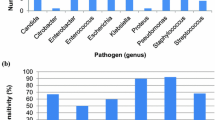Abstract
The risks of urinary tract infection (UTI) and asymptomatic bacteriuria (AB) associated with short-term catheterization have not yet been established. A prospective observational study was carried out to determine the rates of UTI and AB when transurethral Foley catheterization was used for 24 hours. The study population was 193 women undergoing routine gynecologic surgery. All had negative preoperative urine cultures, and prohylactic antibiotics were not used.
Postoperative UTI developed in 16 patients (8.3%), i.e. in only 14 of 86 with a positive culture on day 1 after surgery, and in 2 of 107 with a negative culture on day 1. These 16 women received antibiotics; 79 (40.9%) who had transient AB were not treated. There were no cases of upper UTI. Among 31 women discharged with AB, none developed UTI.
Although 49.2% of patients in this study had postoperative bacteriuria as measured by midstream culture, only 8.3% of patients actually developed a symptomatic infection requiring treatment. As only a minority (11.3%) of patients with postoperative AB actually developed UTI, it appears that to treat all cases of bacteriuria >100 000 cfu/ml is unnecessary.
Similar content being viewed by others
References
Delp Givens C, Wentzel RP. Catheter-associated urinary tract infection in surgical patients: a controlled study on the excess morbidity and cost. J Urol 1980;124:646–648
Hartstein AI, Garber SB, Ward TT et al. Nosocomial urinary tract infection: a prospective evaluation of 108 catheterized patients. Infect Control 1981;2:380–386
Platt R, Polk BF, Murdock B, Rosner B. Mortality associated with nosocomial urinary-tract infection. New Engl J Med 1982;307:637–642
Platt R, Polk BF, Murdock B, Rosner B. Reduction of mortality associated with nosocomial urinary tract infection. Lancet 1983;i:893–897
Schiøtz HA. Voiding after gynecologic surgery: experience with 24-hour Foley catheterization. Int Urogynecol J 1994;5:15–18
Hilton P. Bladder drainage: a survey of practices among gynaecologists in the British Isles. Br J Obstet Gynaecol 1988;95:1178–1189
Schiøtz HA. Routines for bladder drainage after gynecological operations in Norway. Tidsskr Nor Lœgeforen 1991;111:841–843 (in Norwegian, English abstract)
Ireland D, Tacchi D, Bint AJ. Effect of single-dose prophylactic co-trimoxazole on the incidence of gynaecological postoperative urinary tract infection. Br J Obstet Gynaecol 1982;89:578–580
Klarskov P, Bischoff N, Bremmelgaard A, Hald T. Catheter-associated bacteriuria. Acta Obstet Gynecol Scand 1986;65:295–299
Tyreman N-O, Andersson P-O, Kroon L, Orstam S. Urinary tract infection after vaginal surgery. Acta Obstet Gynecol Scand 1986;65:731–733
Kingdom JCP, Kitchener HC, MacLean AB. Postoperative urinary tract infection in gynecology: implications for an antibiotic prophylaxis policy. Obstet Gynecol 1990;76:636–638
Knoff T. Metenaminhippurat. Short-term catheterization after gynecological surgery. Comparison between Hiprex and placebo. Tidsskr Nor Lœgeforen 1985;105:498–499 (in Norwegian, English abstract)
Carpiniello VL, Malloy TR, Cendron M, Booth R, Altman HG. Treatment of urinary complications after total joint replacement in elderly females. Urology 1988;XXXII:186–188
Richardson AC, Lyon JB, Graham EE. Abdominal hysterectomy: relationship between morbidity and surgical technique. Am J Obstet Gynecol 1973;115:953–961
Bartzen PJ, Hafferty FW. Pelvic laparotomy without an indwelling catheter. Am J Obstet Gynecol 1987;156:1426–1432
Nickel JC, Feero P, Costerton JW, Wilson E. Incidence and importance of bacteriuria in postoperative, short-term urinary catheterization. CJS 1989;32:131–132
Kass EH. Asymptomatic infections of the urinary tract. Trans Assoc Am Physicians 1956;69:56–63
Kass EH. Pyelonephritis and bacteriuria. A major problem in preventive medicine. Ann Intern Med 1962;56:46–53
Platt R. Adverse consequences of asymptomatic urinary tract infections in adults. Am J Med 1987;82:47–52
Andersen JT, Heisterberg L, Hebjørn S et al. Suprapubic versus transurethral bladder drainage after colposuspension/vaginal repair. Acta Obstet Gynecol Scand 1985;64:139–143
Author information
Authors and Affiliations
Rights and permissions
About this article
Cite this article
Schiøtz, H.A. Urinary tract infections and bacteriuria after gynecological surgery: Experience with 24-hour foley catheterization. Int Urogynecol J 5, 345–348 (1994). https://doi.org/10.1007/BF00418696
Issue Date:
DOI: https://doi.org/10.1007/BF00418696



